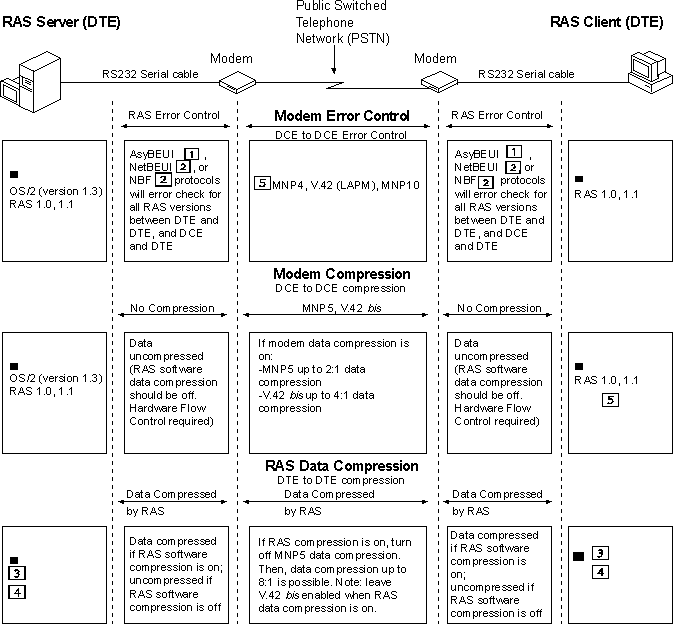
Error control and modem compression are optional features that are available with most modems made in the last few years. For reliable connections, the local and remote modem error control standards must be compatible; and for improved throughput, their modem data and RAS data compression standards must be compatible.
Table E.3 shows the error control and modem data compression standards available with most modems. If you use modem compression, use the error control standard in the cell above the compression value. For instance, if you want to enable error control and modem compression, MNP4 is used with MNP5 or V.42 is used with V.42 bis. MNP4 error control cannot be combined with V.42 bis compression, nor can V.42 error control be combined with MNP5 compression. MNP4 and MNP5 are older standards and are less efficient than V.42 and V.42 bis.
Table E.3 Modem Error Control and Compression Protocols
Modem Error Control Protocol | MNP4 | V.42 w/ LAPM | MNP10 for cellular and land modem connections |
Modem Compression Protocol | MNP5 (up to 2:1 compression) | V.42 bis (up to 4:1 compression) | V.42 bis or MNP5 |
(MNP = Microcom Networking Protocol)
Note
MNP10 is a new, nonstandard, reliable connection protocol not available on most modems. It was designed to overcome cellular modem signal distortion; however, it also makes land connections more reliable. It is not compatible with the Motorola MC2 cellular protocol, nor the AT&T EC2 cellular protocol, as of July 1995. MNP10 is combined with V.42 bis compression.
Figure E.3 illustrates modem error control standards, modem compression standards, and RAS software data compression. The Figure has three horizontal sections whose titles you can find in the center column directly below the modem-to-modem link graphic at the top of the Figure. To read the information in this Figure, decide which of the following three sections you want to focus on: Modem Error Control, Modem Data Compression, or RAS Data Compression. Then find that section in the center column and read the entries to the left and right in the same horizontal row. This enables you to determine whether the standard or feature also applies to the modem-to-computer link, and which RAS client versions and server versions support the modem or RAS feature in this section.

Figure E.3 Modem Error Control Standards, Modem Compression Standards, and RAS Software Data Compression
n RAS for Windows for Workgroups 3.11, Windows NT 3.1, Windows NT Advanced Server 3.1, Windows NT Workstation 3.5 or later, Windows NT Server 3.5 or later, Windows 95.
1 AsyBEUI applies to RAS versions 1.x only.
2 NetBEUI applies to RAS for Windows for Workgroups 3.11, and NBF applies to Windows NT versions 3.1, 3.5, and 3.51.
3 In case you have not disabled your RAS software compression on the Options menu of your RAS client, check the size of the RASMAC.386 files. If it has only 27193 bytes, it does not have RAS compression. If RASMAC.386 has 49209 bytes, then it has RAS compression support. The file with RAS compression support can be obtained on the Windows NT 3.5 U.S. Service Pack 2 CD in the SUPPORT\RAS directory.
4 In case you have not disabled your RAS software compression on the Options menu of your RAS client, check the size of the ASYNCMAC.SYS file. If it has only 33732 bytes, it does not have RAS compression. The releases of ASYNCMAC.SYS with 53188 bytes and 53716 bytes have RAS compression support. The files with RAS compression support can be obtained on the Windows NT 3.5 U.S. Service Pack 2 compact disc in the SUPPORT\RAS directory.
5 RAS 1.0 and 1.1 were tested only with US Robotics V.32 bis modems at 14400 bps line speed. The modems were configured for V.42, V.42 bis, and V.32 bis. The OS/2 1.3 LAN Manager RAS 1.0 or 1.1 server had an intelligent DigiBoard installed.